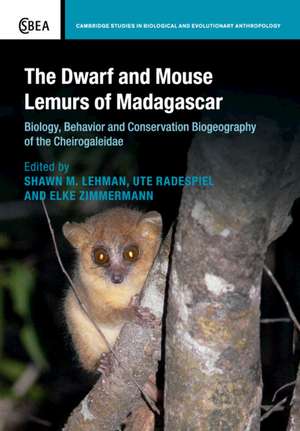The Dwarf and Mouse Lemurs of Madagascar: Biology, Behavior and Conservation Biogeography of the Cheirogaleidae: Cambridge Studies in Biological and Evolutionary Anthropology, cartea 73
Editat de Shawn M. Lehman, Ute Radespiel, Elke Zimmermannen Limba Engleză Paperback – 24 iun 2020
Din seria Cambridge Studies in Biological and Evolutionary Anthropology
-
 Preț: 479.80 lei
Preț: 479.80 lei -
 Preț: 390.85 lei
Preț: 390.85 lei - 14%
 Preț: 750.86 lei
Preț: 750.86 lei - 11%
 Preț: 700.59 lei
Preț: 700.59 lei - 14%
 Preț: 722.61 lei
Preț: 722.61 lei - 9%
 Preț: 846.81 lei
Preț: 846.81 lei - 11%
 Preț: 460.98 lei
Preț: 460.98 lei - 11%
 Preț: 566.50 lei
Preț: 566.50 lei -
 Preț: 367.91 lei
Preț: 367.91 lei - 11%
 Preț: 693.77 lei
Preț: 693.77 lei -
 Preț: 356.37 lei
Preț: 356.37 lei - 11%
 Preț: 633.61 lei
Preț: 633.61 lei - 11%
 Preț: 619.90 lei
Preț: 619.90 lei -
 Preț: 396.29 lei
Preț: 396.29 lei -
 Preț: 279.00 lei
Preț: 279.00 lei -
 Preț: 304.74 lei
Preț: 304.74 lei -
 Preț: 371.32 lei
Preț: 371.32 lei -
 Preț: 376.06 lei
Preț: 376.06 lei -
 Preț: 332.66 lei
Preț: 332.66 lei -
 Preț: 421.01 lei
Preț: 421.01 lei -
 Preț: 303.60 lei
Preț: 303.60 lei -
 Preț: 309.27 lei
Preț: 309.27 lei -
 Preț: 376.62 lei
Preț: 376.62 lei - 11%
 Preț: 424.92 lei
Preț: 424.92 lei -
 Preț: 308.50 lei
Preț: 308.50 lei -
 Preț: 317.11 lei
Preț: 317.11 lei -
 Preț: 453.33 lei
Preț: 453.33 lei -
 Preț: 322.41 lei
Preț: 322.41 lei -
 Preț: 433.83 lei
Preț: 433.83 lei -
 Preț: 435.78 lei
Preț: 435.78 lei -
 Preț: 471.93 lei
Preț: 471.93 lei - 11%
 Preț: 474.71 lei
Preț: 474.71 lei -
 Preț: 428.90 lei
Preț: 428.90 lei - 14%
 Preț: 934.70 lei
Preț: 934.70 lei
Preț: 427.04 lei
Nou
Puncte Express: 641
Preț estimativ în valută:
81.74€ • 88.82$ • 68.71£
81.74€ • 88.82$ • 68.71£
Carte tipărită la comandă
Livrare economică 21 aprilie-05 mai
Preluare comenzi: 021 569.72.76
Specificații
ISBN-13: 9781108828857
ISBN-10: 110882885X
Pagini: 572
Ilustrații: 88 b/w illus. 29 colour illus.
Dimensiuni: 170 x 245 x 31 mm
Greutate: 0.93 kg
Editura: Cambridge University Press
Colecția Cambridge University Press
Seria Cambridge Studies in Biological and Evolutionary Anthropology
Locul publicării:Cambridge, United Kingdom
ISBN-10: 110882885X
Pagini: 572
Ilustrații: 88 b/w illus. 29 colour illus.
Dimensiuni: 170 x 245 x 31 mm
Greutate: 0.93 kg
Editura: Cambridge University Press
Colecția Cambridge University Press
Seria Cambridge Studies in Biological and Evolutionary Anthropology
Locul publicării:Cambridge, United Kingdom
Cuprins
List of contributors; Foreword; Part I. Cheirogaleidae: Evolution, Taxonomy, and Genetics: 1. Cheirogaleid diversity and evolution: big questions about small primates; 2. The taxonomy of Cheirogaleidae: an ever expanding species list; 3. Mitogenomics of the family Cheirogaleidae and relationships to taxonomy and biogeography; 4. Why cheirogaleids are bad models of primate ancestors: a phylogenetic reconstruction; 5. Contact zones and species sympatry in dwarf lemurs (Genus Cheirogaleus): the roles of ecological adaptation and sexual selection; Part II. Methods for Studying Captive and Wild Cheirogaleids: 6. How to anesthetize mouse lemurs; 7. Microcebus murinus – a unique primate for modeling human brain disorders, including Alzheimer's disease and bovine spongiform encephalopathy; 8. Life history variation in mouse lemurs: the effect of environmental and phylogenetic determinants; 9. The effects of the lunar cycle, temperature, and rainfall on the trapping success of wild brown mouse lemurs (Microcebus rufus) in Ranomafana National Park, southeastern Madagascar; 10. Tiny samples from tiny lemurs: methodological considerations for endoparasite analyses in mouse lemurs; 11. A review of ectoparasites in the Cheirogaleidae; Part III. Cheirogaleidae: Behavior and Ecology: 12. Morphology, behaviour, ranging patterns and habitat use of the northern giant mouse lemur (Mirza zaza) in Sahamalaza, northwestern Madagascar; 13. Living in riverine and xeric forests: Microcebus griseorufus at Beza Mahafaly, SW Madagascar; 14. Determinants of intra- and interspecific isotopic variation in mouse lemurs from northwestern Madagascar; 15. Your food, my food: patterns of resource use in two sympatric mouse lemur species; 16. The physiology of phyletic dwarfism in Cheirogaleidae; 17. Possible causes and consequences of different hibernation patterns in Cheirogaleus species – Mitovy fatsy sahala; 18. Seed dispersal by mouse lemurs: Do Microcebus represent a unique frugivorous guild?; Part IV. Cheirogaleidae: Sensory Ecology, Communication, and Cognition: 18. Seed dispersal by mouse lemurs: do Microcebus represent a unique frugivorous guild?; 19. Predation in the dark: anti-predator strategies of Cheirogaleidae and other nocturnal primates; 20. The gray mouse lemur (Microcebus murinus): a novel cognitive primate brain aging model; 21. Acoustic divergence in communication of cheirogaleids with special emphasis to mouse lemurs; 22. Modeling the origins of primate sociality: social flexibility and kinship in mouse lemurs (Microcebus spp.); Part V. Cheirogaleidae: Conservation Biogeography: 23. Ecological niche modeling of mouse lemurs (Microcebus spp.) and its implications for their species diversity and biogeography; 24. Edge effects on tree dendrometrics, abiotics, and mouse lemur densities in western dry forests in Madagascar; 25. Factors determining Microcebus abundance in a fragmented landscape in Ankarafantsika National Park, Madagascar; 26. Can behavioural ecology help to understand the divergent range sizes of mouse lemurs?; 27. Conservation biology of the Cheirogaleidae: future research directions; Index.
Recenzii
'… a very useful overview for anyone interested in nocturnal primates and in Madagascan biogeography. Many of the chapters provide excellent syntheses and cover conflicting theories, backed by a ready-made reading list on the subject, which contextualise the datasets presented to help address particular questions. There is no doubt our knowledge of these cryptic little lemurs will continue to expand substantially in the future, building on many of the diverse studies presented in this book.' Anna T. C. Feistner, Primate Eye
Descriere
The first ever reference book on the behaviour, physiology, conservation and biogeography of the dwarf and mouse lemurs of Madagascar.
